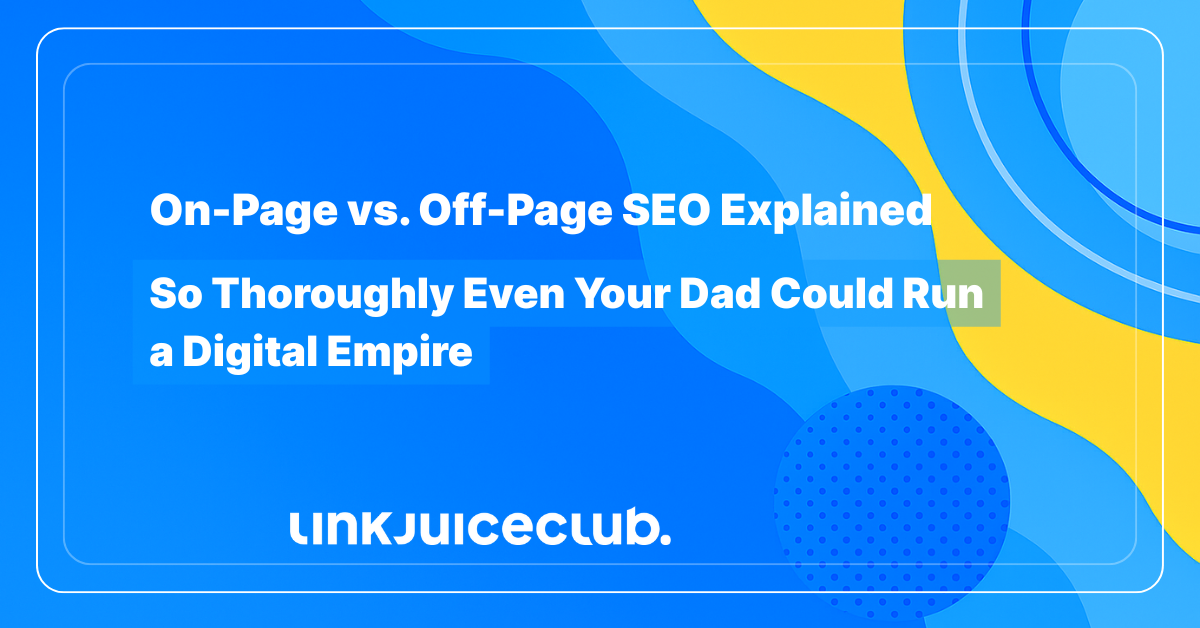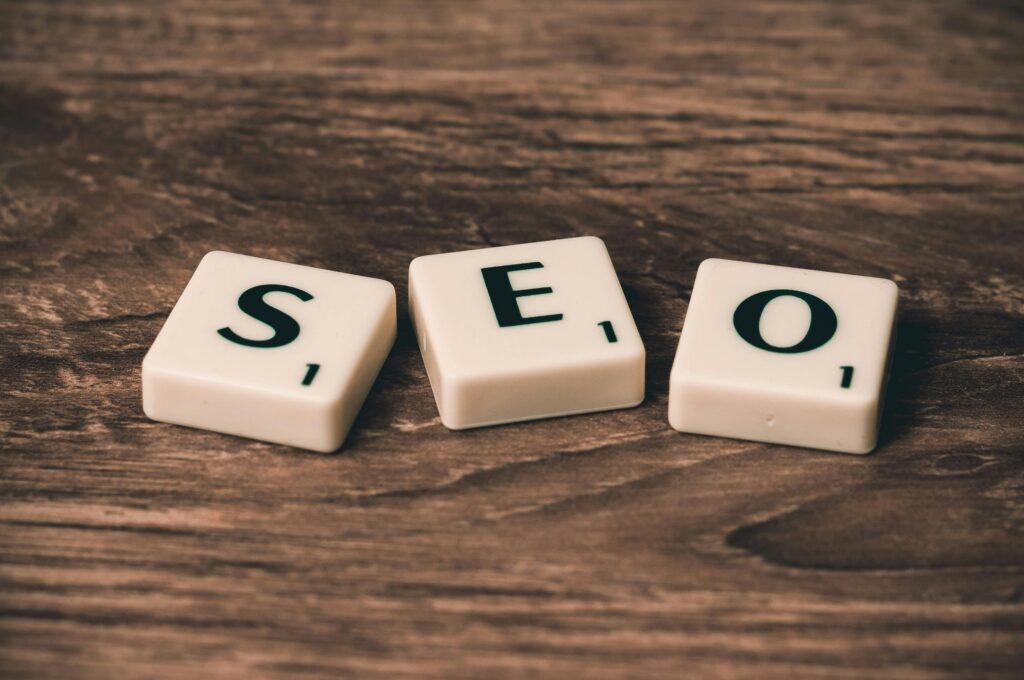
On-Page vs. Off-Page SEO Explained (So Thoroughly Even Your Dad Could Run a Digital Empire)
Let’s not charge in blind. Before we start picking sides, we need to understand what this whole SEO business is about. People treat it like wizardry, but really, it’s just knowing how to make your website pull its weight.
What On Earth is SEO and Why Is Everyone Obsessed with It?
SEO stands for Search Engine Optimisation. In plain terms, it’s how you get your website to show up when someone Googles something vaguely related to what you offer. You don’t pay for it like you would with ads. Instead, you earn your place on the results page. It’s like getting invited to the front row of a concert because the organisers genuinely think you belong there.

Now, SEO isn’t just one thing. It’s a collection of moving parts, and those parts are split into two main categories: On-Page SEO and Off-Page SEO. The difference is like tidying your living room versus having your neighbours rave about how lovely your home is. On-Page is everything you control on your website. Off-Page is everything that happens outside your site but affects your reputation.
Both are crucial. You can’t just polish your shoes and forget to leave the house. Nor can you be the most charming person at the party if you haven’t brushed your teeth. You need both to work in sync if you want to rank well on Google and keep your online visitors coming back.
Why You Absolutely Must Separate On-Page and Off-Page SEO in Your Mind
Imagine you’re fixing up a car. You wouldn’t lump the engine and the paint job into the same maintenance checklist, would you? No. You’d service the engine (On-Page SEO) to make sure the car runs smoothly, and you’d buff the paintwork (Off-Page SEO) so it looks the part when people see it.
On-Page SEO is about substance: what your website says, how it’s structured, how fast it loads, and whether it makes sense to users and to search engines. It’s what search engines read when they scan your pages. This is your domain. You build it, polish it, and make sure it behaves.
Off-Page SEO, meanwhile, is about reputation. Do people talk about your site? Do other websites link to it? Are you the digital equivalent of a well-regarded local butcher, or are you that bloke who once got caught putting sawdust in sausages?
By separating the two, you stop yourself from missing vital steps. You begin to treat your website like a proper business asset. And, most importantly, you can actually see what’s working and what needs fixing. Bundling everything into one vague “SEO” bucket is lazy thinking, and lazy thinking never helped anyone rank on Google.
🛠️ Crafting a Proper Strategy for On-Page SEO: Like Renovating Your House for Visitors and Surveyors Alike
Let’s start with On-Page SEO. This is your turf. Think of it like fitting your house with working plumbing, solid flooring, and clear signage on the door.
1. Keyword Research
Start with figuring out what your audience is searching for. Not just general ideas like “cheap trainers” but long, specific phrases like “affordable waterproof running shoes for trail hiking.” These phrases are known as long-tail keywords, and they’re your goldmine. Use tools like Google Keyword Planner, Ahrefs, or SEMrush to discover what your audience is hunting for, then pepper those terms into your pages in a natural, readable way.
2. Content That Isn’t Just Noise
Write for humans, but nod politely to the algorithms. Each page should answer a question or solve a problem. No fluff. Include clear headings (H1 for the title, H2s and H3s for subtopics), and use images, videos, and diagrams where they help. Don’t waffle. Don’t pad. Just say what matters.
3. URLs That Make Sense
Your URLs should be short, sweet, and make logical sense. No random numbers or symbols. “/mens-blue-running-shoes” is fine. “/product-id-3421shb2e” is a disaster.
4. Meta Titles and Descriptions
These are the bits that show up in search engine results. Titles should grab attention and include your main keyword. Descriptions should tempt people to click without sounding like a dodgy sales pitch.
5. Internal Linking
Link related pages together. If someone’s reading your blog post about running shoes, send them to your product page. If they’re on your homepage, direct them to your FAQs. It helps users navigate and lets search engines understand your site’s hierarchy.
6. Mobile Friendliness and Speed
Your website must load fast. Anything over three seconds, and people start drifting off. Optimise your images, minimise code bloat, and make sure it all works seamlessly on mobile. Google uses mobile-first indexing, so don’t treat smartphones like second-class citizens.
7. Schema Markup
This is structured data added to your pages that helps search engines display rich snippets – those fancy results with star ratings, pricing info, or product availability. It doesn’t directly boost rankings, but it increases click-through rates, and that’s half the battle.
8. Accessibility and Clean Code
Use semantic HTML. Provide alt text for images. Ensure proper contrast and font sizes. Google isn’t blind, but it rewards sites that are usable by everyone, including people using screen readers or slower connections.
Once you’ve nailed all this, On-Page SEO keeps your visitors happy, your bounce rate low, and Google convinced that your site is the best thing since sliced bread.
🧲Creating an Effective Off-Page SEO Strategy: Earning Trust, One Mention at a Time
Now let’s stroll out into the digital neighbourhood and see what people are saying about you.
1. Backlinks: The Ultimate Stamp of Approval
The cornerstone of Off-Page SEO is backlinks – links from other websites to yours. Think of these as votes of confidence. But not all votes are equal. A link from The Guardian counts far more than a link from Uncle Jeff’s blog about spoons.
Focus on getting links from relevant, high-authority sites. This involves outreach. You might write guest posts, offer expert quotes to journalists, or create genuinely useful content that people can’t help but share.
2. Digital PR
This isn’t just old-fashioned press releases. Digital PR means building relationships with writers, editors, influencers, and niche bloggers. If you launch a new product or have original research, let people know. Use platforms like HARO or ResponseSource. If you’re seen as a reliable, quotable expert, journalists will come back for more.
3. Social Media Engagement
While social signals don’t directly influence rankings (Google swears they don’t, but let’s be honest, they probably do), a strong presence on social media drives traffic and increases the chance of backlinks. Share your content, engage in comments, build a community. Popularity breeds authority.
4. Brand Mentions
Even without links, if your brand keeps popping up on forums, news sites, and reviews, search engines take note. Make sure your name appears consistently. That means using the same business name, address, and phone number across all platforms.
5. Review Sites and Business Listings
Encourage reviews on platforms like Trustpilot, Google Business Profile, Yelp, or sector-specific directories. Good reviews improve your credibility, and even average ones give you opportunities to show good customer service. Keep your business information consistent everywhere.
6. Influencer Collaborations and Partnerships
If you can’t get coverage from the BBC, get an industry influencer to mention you. A YouTuber or podcaster in your niche who loves your product or content can send waves of targeted traffic your way, often with more impact than traditional media.
The golden rule of Off-Page SEO? Be useful and trustworthy. The internet reflects what people care about. If your brand genuinely solves problems or entertains, Off-Page SEO will follow.
🎯 The Real-World Benefits of Nailing Both Sides
Here’s where everything clicks into place. If you get your On-Page SEO in order, people will find your site and stick around. If your Off-Page SEO is strong, more people will trust you, link to you, and refer others. And Google? It loves both.
You’ll notice:
- Improved rankings across a wider variety of keywords
- Increased traffic from organic search, often the most sustainable long-term source
- Higher engagement because visitors find what they’re looking for faster
- Better conversions since your site looks and feels credible
- More mentions online, which lead to more backlinks, which loops back to more traffic
It’s a snowball. Once it starts rolling, everything gets easier, but only if the foundation is rock solid.
SEO is No Longer Optional
Here’s the honest truth: if your website isn’t optimised both on-page and off-page, you’re invisible. You may as well build a lovely pub in the middle of the woods and forget to tell anyone the address.
When you give both sides their full attention, structure your content with care, refine the technical setup, and build genuine connections across the web, the results become measurable and genuinely satisfying.
So whether you’re running a small business, a blog, or an ecommerce giant, treat On-Page and Off-Page SEO like two halves of a full English breakfast. Miss one, and the whole plate feels lacking. Get them both right, and you’re in for a brilliant morning, every day.





